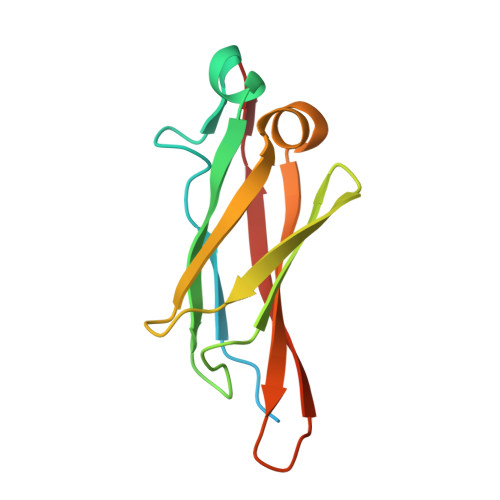Role of Ca(2+) in folding the tandem beta-sandwich extender domains of a bacterial ice-binding adhesin.
Guo, S., Garnham, C.P., Karunan Partha, S., Campbell, R.L., Allingham, J.S., Davies, P.L.(2013) FEBS J 280: 5919-5932
- PubMed: 24024640
- DOI: https://doi.org/10.1111/febs.12518
- Primary Citation of Related Structures:
4KDV, 4KDW - PubMed Abstract:
A Ca(2+) -dependent 1.5-MDa antifreeze protein present in an Antarctic Gram-negative bacterium, Marinomonas primoryensis (MpAFP), has recently been reassessed as an ice-binding adhesin. The non-ice-binding region II (RII), one of five distinct domains in MpAFP, constitutes ~ 90% of the protein. RII consists of ~ 120 tandem copies of an identical 104-residue sequence. We used the Protein Homology/analogy Recognition Engine server to define the boundaries of a single 104-residue RII construct (RII monomer). CD demonstrated that Ca(2+) is required for RII monomer folding, and that the monomer is fully structured at a Ca(2+) /protein molar ratio of 10 : 1. The crystal structure of the RII monomer was solved to a resolution of 1.35 Å by single-wavelength anomalous dispersion and molecular replacement methods with Ca(2+) as the heavy atom to obtain phase information. The RII monomer folds as a Ca(2+) -bound immunoglobulin-like β-sandwich. Ca(2+) ions are coordinated at the interfaces between each RII monomer and its symmetry-related molecules, suggesting that these ions may be involved in the stabilization of the tandemly repeated RII. We hypothesize that > 600 Ca(2+) ions help to rigidify the chain of 104-residue repeats in order to project the ice-binding domain of MpAFP away from the bacterial cell surface. The proposed role of RII is to help the strictly aerobic bacterium bind surface ice in an Antarctic lake for better access to oxygen and nutrients. This work may give insights into other bacterial proteins that resemble MpAFP, especially those of the large repeats-in-toxin family that have been characterized as adhesins exported via the type I secretion pathway.
- The Protein Function Discovery Group, Department of Biomedical and Molecular Sciences, Queen's University, Kingston, Ontario, Canada.
Organizational Affiliation:


















